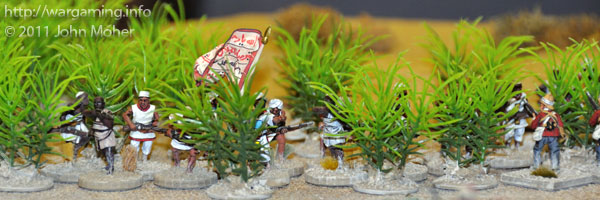
When BattleCry 2011 in Auckland was looming earlier this year I had promised Gerry from Castaway Arts to help with some Colonial TSATF demo & participation games (and provide the troops & terrain to save Gerry bringing it over from Cairns, Australia), and as part of that I wanted to try and have some new troops and terrain on table to add something fresh to the appearance. The troops were covered by the presence of the first of my Gunboats (which had just been completed for me by Kieran of 6mm Wargaming) and the inaugural outing of my British Infantry in Grey Uniforms (See the report of our third BattleCry 2011 TSATF Game). However terrain was a different story – as always I was leeching off Kieran for his Palm Trees – I do have my own, around 400 of them actually (and about 10 different types and sizes), but getting to basing and finishing them is a different story – but anyway, it otherwise was pretty much all standard stuff (well illustrated on this blog over the past few years). I needed something quick, easy, and cheap, to churn out a piece of quick new terrain…
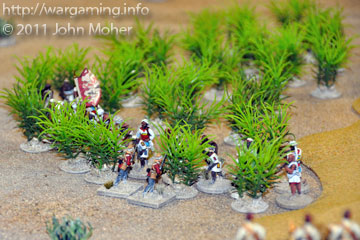
Plastic aquarium plants were the answer – a common source of terrain for many a Colonial Gamer and others, I have had this on my list for several years but had never got around to doing much with it – although Kieran scored a large amount for himself and has churned out a lot of great jungle terrain (see our Adventuring for the Kaiser in Darkest Africa game reports). So I was looking around the local pet shops in my part of Auckland, and there weren’t that many of them, and I came across “Springer Grass” from Aqua One (who have distributors in NZ, AU, UK, HK, etc). I instantly thought that that could serve quite well for some generic 28mm ‘Sudanish’ thorn thickets, as often referenced in the memoirs and accounts from the time. What’s more, they’ll be useful for North West Frontier scrub as well, and done right I should get triple duty from these so they can be used as ‘Jungle Thickener’ for the Pacific/Far-East (for my 20mm WW2 gaming) – they could help provide extra depth to the foliage ‘under the canopy of palms and such.
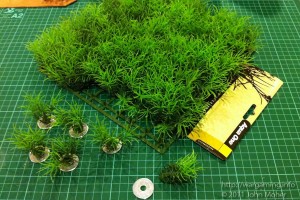
The beauty of these is the need very little work – and you get a tray of 100 for under NZ$25 (that’s about US$18 at exchange rates, but things are always more expensive in NZ due to lack of volume so you probably get them over there for about US$10 or so) – so for me that’s 4 for a $1, or as each one has 4 ‘trunks’ about 6 cents per ‘trunk’! All that’s needed is to pop them off the tray and mount them on anything suitable – I chose washers (as they had the bonus of adding a little weight to the thickets) but you could put several on an old Combat Disc or on strips of cardboard, or such… A Hot Glue Gun is probably the best way to fix them down, but I just used PVA (i.e. White Woodworking/Paper Glue) so I could easily remove them if everything went belly-up! The only thing with them is they have an unusual base – it’s rounded with a hole in the middle for the tray spike – so they don’t naturally sit upright well on their own (see image of one on its side).
So you’ll need to prop them upright or if using a hot glue gun hold them for a few moments until the glue has set. Once it has you need to ‘fill in’ the central hole – in my case I just parted the fronds and dolloped in a lump of silicone sealant (i.e. caulking compound) with a small screwdriver’s tip. You could use anything you normally use for texturing your bases of course.
Next step is to texture the base – in my case I had used 25mm (1”) washers – which were the perfect size – so I just needed to do a thin strip round the edge and hide/blend in the base of the plant itself (which is a bit pronounced), you can see from the photos of the completed thorn thickets that it was pretty rudimentary but worked pretty well (in my opinion of course). Once textured with my usual basing mix the base (including the centre of the plant) were suitably painted and dry brushed my usual basing colours (for the Sudan).
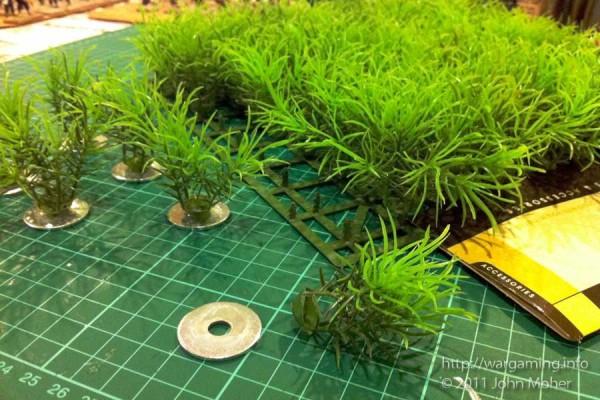
The fourth step was to then spray them with a fairly good matt varnish – to take the ’shine’ and ‘plasticy’ look off them – this worked surprising well – although they are still a bit too bright and plasticy (see the game photos of the completed thickets). As a result a final ‘fifth step’ will be required which is a light feathering spray of a light brown or tanny dust like colour to ‘tone down’ the brightness. Having matt varnished them first the paint will take to the plastic better and not need to be too heavy, just a feathering to lightly and partially coat the plants.
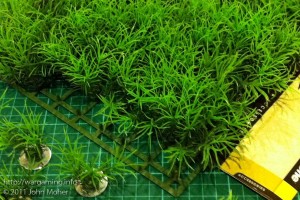
I have yet to do the final step, as I still have 60 of the little chaps to base onto their washers yet – but once I do I will post a couple of final images of them completed! Meanwhile I’m generally pretty happy with them as a cheap and nasty terrain solution – they provide an interesting and different type of foliage on the table, don’t look too out of place even without the colour toned down, and open opportunities for some unusual terrain effects in games (how quickly can you move through a dense thorn thicket where the plants are covered in 2” long thorns)!
P.S. A thought for TSATF games might be troops moving through such a thicket may never charge, and lose 1 die before they roll for movement, then still lose their highest die or halve the total for rough terrain as normal! This would mean it’s impossible to move through them in a close order line or square (forcing Imperial troops to use Open Order), and even Native troops will get disadvantaged by them.
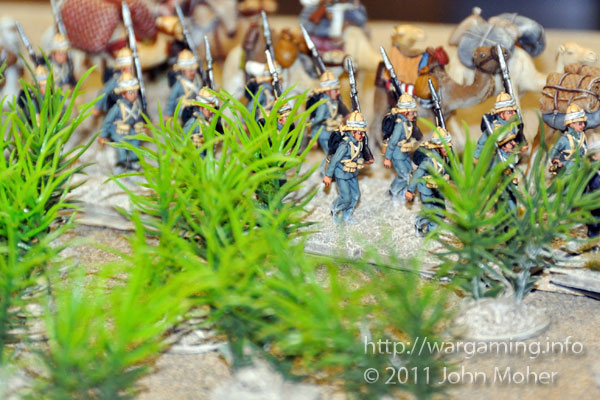
See my initial Thorn Thicket in it’s first outings at BattleCry 2011 Game 1, Game 2, and Game 3.
I have used this product (or a similar one) in the States. You can also cut it into larger sections by clipping the lattice holding the pieces. Then you can have impenetrable areas.
Jim
Hi Jim – yes, I have considered something like that – using a ‘CD’ as the base – as I thought it’d be good for putting in the centre of an area to create thick dense area – however I’m a bit undecided, although I may still do so as I do have an awful lot of these things! 🙂
Actually even doing that individually would be a great idea – I never thought of that – if you cut the frame up so each plant has it’s own little X base it’d make basing much easier (as that’d go on a washer a lot easier than an unstable rounded plant on it’s own and the ‘spike’ would help provide more centre density for each plant…
Cheers – you’ve made me think laterally about how to do the remainder of this tray of plants!